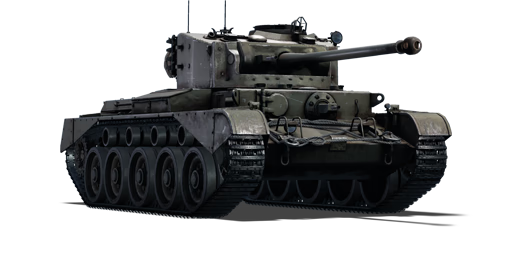



The Comet I is a British medium tank. It was introduced in Update 1.55 "Royal Armour" along with the initial British ground tree. Armed with a 77 mm HV gun, essentially a 17-pounder with a lower muzzle velocity, it has one of the more powerful guns available for a medium tank at the rating.
The Comet is an excellent medium tank. It has great mobility and acceleration, able to reach 38 km/h very quickly and stay there in full throttle, but its reverse speed is pitiful like the Cromwell. Firepower is also a benefit of the vehicle, especially after the unlocking of the APDS shot, giving it the penetration needed to deal with any threat you might encounter. The drawback of the design is the sub-par armour that can be pretty easily penetrated at BR 5.3. One should take advantage of the Comet's low profile and mobility to hide and manoeuvre from the enemy to catch them at an advantageous angle. The Comet also has a benefit the previous tanks in its branch, the Sherman Firefly, didn't have in the great gun depression. This allows the Comet to more easily fire over hills in an hull-down position to destroy the enemy with a terrain benefit for protection.
The Comet has an olive drab colour like all other British tanks. It is also quite low in stature. The Comet has a unique turret design and has a nice long barrel. The barrel has a muzzle brake at the end of it. The machine gun beside the driver doesn't work.
| Ammunition | Type | Armor penetration (mm) at a distance: | |||||
|---|---|---|---|---|---|---|---|
| 10 m | 100 m | 500 m | 1000 m | 1500 m | 2000 m | ||
| AP | 145 | 142 | 131 | 118 | 106 | 96 | |
| HE | 9 | 9 | 9 | 9 | 9 | 9 | |
| APC | 145 | 142 | 131 | 118 | 106 | 96 | |
| APCBC | 161 | 158 | 145 | 131 | 118 | 107 | |
| APDS | 217 | 213 | 199 | 182 | 167 | 153 | |
| Belt | Belt filling | Armor penetration (mm) at a distance: | |||||
|---|---|---|---|---|---|---|---|
| 10 m | 100 m | 500 m | 1000 m | 1500 m | 2000 m | ||
| AP-I/AP-I/AP-T | 9 | 8 | 6 | 3 | 0 | 0 | |












Mobility | |
|---|---|
Protection |
|---|
Firepower | |
|---|---|